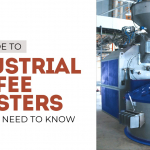Introduction: The Labor Challenge in Coffee Processing
The coffee industry faces unprecedented labor challenges. Processing facilities worldwide are grappling with rising wage demands, persistent labor shortages, and increasing training costs—all while market pressures demand consistent quality and competitive pricing. These pressures are particularly acute during harvest seasons when temporary labor needs surge dramatically.
Recent industry data reveals telling statistics:
- Labor costs now represent 35-45% of total operating expenses in traditional coffee processing operations
- Seasonal labor availability has declined by 15-20% in major coffee-producing regions over the past five years
- Wage inflation in agricultural sectors is outpacing general inflation by 2-3% annually in many coffee-growing countries
- Employee turnover rates in processing facilities average 30-40% annually, creating significant retraining costs
Amid these challenges, automation technologies have emerged as a transformative solution. Smart coffee processing equipment doesn’t merely replace human labor—it enhances efficiency, improves consistency, reduces waste, and ultimately delivers superior ROI through sustained operational improvements.
Understanding Traditional Coffee Processing Labor Requirements
Before examining automation solutions, it’s essential to understand the traditionally labor-intensive nature of coffee processing:
Pre-Processing Labor Requirements
Traditional coffee processing begins with receiving and sorting, where workers manually inspect and sort incoming coffee cherries. A mid-sized processing facility handling 5-10 tons of cherries daily typically requires 8-12 workers dedicated to these initial stages, representing approximately 20% of total labor hours.
Primary Processing Labor Demands
The core processing stages—depulping, fermentation, washing, and drying—have historically required significant manual supervision and intervention:
- Depulping and washing: 5-8 workers monitoring machinery, adjusting settings, and ensuring proper cherry separation
- Fermentation management: 2-4 workers monitoring fermentation tanks, testing pH levels, and determining optimal processing times
- Drying operations: 8-15 workers spreading, raking, covering, and monitoring coffee on drying patios or operating mechanical dryers
Secondary Processing Labor Costs
Once coffee parchment is dried, secondary processing involves:
- Hulling and polishing: 4-6 workers operating machinery and monitoring quality
- Sorting: 10-20 workers performing visual inspection and manual removal of defects
- Grading and classification: 3-5 specialized workers evaluating coffee quality
- Packaging and warehousing: 5-8 workers handling bagging, weighing, and storage
In total, a traditional mid-sized wet processing operation may employ 50-80 workers during peak season, with labor representing the largest single operating expense. This labor-intensive model has become increasingly unsustainable as labor markets tighten and costs rise.
Automation Technologies Transforming Coffee Processing
Advanced automation is revolutionizing each stage of coffee processing, dramatically reducing labor requirements while improving consistency and quality.
Smart Receiving and Sorting Systems
Intelligent receiving stations now incorporate:
- Optical scanning technology that automatically assesses cherry ripeness, size, and quality with 95-98% accuracy
- Weight-based sorting systems that separate cherries by density and ripeness
- Conveyor systems with integrated metal detection to prevent equipment damage
- Digital documentation of batch information tied to farm-level traceability systems
Labor Impact: These systems typically reduce receiving labor requirements by 60-70%, with one or two operators managing what previously required 8-12 workers.
Automated Depulping and Washing
Modern depulping and washing systems feature:
- Self-adjusting depulpers that automatically calibrate to cherry size and ripeness
- Water recirculation systems that optimize water usage while ensuring proper mucilage removal
- Computerized fermentation monitoring with pH, temperature, and time tracking
- Continuous-flow processing lines that eliminate batch handling requirements
Labor Impact: Automated washing stations reduce labor needs by 50-65% compared to traditional operations while improving consistency.
Self-Adjusting Drying Systems with Moisture Monitoring
Advanced drying technologies include:
- Sensor-equipped mechanical dryers that continuously monitor moisture content with ±0.5% accuracy
- Automated airflow and temperature controls that adapt to ambient conditions and coffee moisture levels
- Rotational systems that ensure even drying without manual raking
- Real-time data logging for quality assurance and process optimization
Labor Impact: Modern drying operations reduce labor requirements by 70-80% compared to traditional sun-drying methods while improving consistency and reducing drying time by 30-50%.
Robotic Hulling and Polishing
Secondary processing has been transformed by:
- Fully automated hulling lines with precision calibration to minimize breakage
- Density-based separation technologies that replace manual sorting
- Polishing systems with real-time performance monitoring
- Integrated dust collection and air quality management
Labor Impact: Automated hulling and polishing reduces labor needs by 60-70% while improving whole bean percentages by 3-5%.
AI-Powered Optical Sorting
Perhaps the most revolutionary advancement is in sorting technology:
- Multi-spectrum camera systems that detect defects invisible to the human eye
- AI algorithms that continuously improve detection accuracy through machine learning
- High-speed air ejection systems that remove defects with pinpoint precision
- Shape, size, and color classification that enables precise product specifications
Labor Impact: Electronic sorting reduces sorting labor by 80-90% compared to hand sorting while typically increasing detection accuracy by 15-20%.
Automated Packaging Systems
End-of-line automation includes:
- Precision weighing and filling systems with accuracy to ±0.1%
- Automated bag handling and sealing with nitrogen flushing capabilities
- Robotic palletizing systems for efficient warehouse operations
- Integrated labeling and lot tracking
Labor Impact: Modern packaging lines reduce labor requirements by 60-75% compared to manual operations.
Integrated Quality Control Technologies
Quality assurance has been enhanced by:
- In-line moisture analysis at multiple process stages
- Sample roasting and spectral analysis for batch consistency
- Defect identification systems with digital documentation
- Environmental monitoring for food safety compliance
Labor Impact: Automated QC reduces quality control staffing needs by 40-50% while typically improving consistency measures by 25-30%.
Quantifying the ROI of Automation Investments
The financial case for automation is compelling when examining comprehensive ROI calculations:
Labor Reduction Metrics
A mid-sized processing operation transitioning to comprehensive automation typically sees:
- Overall labor reduction: 60-75% decrease in total labor hours
- Specialized labor shifts: 80-90% reduction in unskilled positions, offset by 10-20% increase in technical roles
- Overtime elimination: Near-complete elimination of premium-pay overtime hours
- Training cost reduction: 50-60% decrease in annual training expenses due to lower turnover and fewer total positions
Productivity Improvements
Beyond direct labor savings, productivity gains enhance ROI:
- Throughput increases: 30-50% higher processing capacity with the same facility footprint
- Extended operating hours: Ability to operate 20-24 hours daily with minimal additional staffing
- Reduced downtime: 15-25% improvement in equipment utilization through predictive maintenance
- Seasonal flexibility: Ability to scale operations up or down with minimal staffing adjustments
Quality-Related Financial Benefits
Improved consistency delivers financial advantages:
- Defect reduction: 30-40% fewer quality-related rejections
- Grade improvements: 10-15% increase in premium-grade output from the same input material
- Customer satisfaction: Measurable reduction in quality-related claims and returns
- Price premiums: 5-12% higher realized prices through improved quality consistency
Case Study: Model ROI Calculation
For a processing facility handling 3 million pounds annually:
- Initial automation investment: $750,000-1,200,000
- Annual labor savings: $180,000-250,000
- Annual quality improvement value: $90,000-150,000
- Annual capacity utilization benefits: $60,000-100,000
- Total annual financial benefit: $330,000-500,000
- Typical payback period: 2.5-3.5 years
- 5-year ROI: 120-180%
The Quality Connection: Automation and Consistency
Automation delivers labor savings while simultaneously enhancing quality outcomes through improved consistency:
Precision Processing Parameters
Automated systems maintain precise control over critical variables:
- Temperature variations held within ±1°C throughout processing
- Fermentation times managed to within 15-minute windows based on pH monitoring
- Moisture content controlled to within ±0.5% during drying
- Size sorting accuracy to within 0.2mm screen differentials
Elimination of Human Variability
Human judgment, while valuable, introduces inconsistency:
- Manual sorting accuracy typically ranges from 85-93% depending on worker experience and fatigue
- Hand-managed drying operations show 3-5% moisture content variation across batches
- Manual processing parameter adjustments often lag behind optimal timing
Documentation and Traceability
Automation enables comprehensive quality documentation:
- Complete digital records of processing parameters for every batch
- Traceability from receiving through final packaging
- Real-time alerts when parameters drift from optimal ranges
- Data-driven process optimization through historical performance analysis
Scalable Solutions: Automation for Operations of All Sizes
Contrary to common perception, automation solutions exist for operations of all scales:
Entry-Level Automation
Small processors handling 50,000-250,000 pounds annually can implement targeted automation:
- Semi-automated pulping and washing systems ($15,000-40,000)
- Basic moisture monitoring equipment ($5,000-12,000)
- Small-scale color sorters ($30,000-60,000)
- Semi-automated packaging systems ($20,000-45,000)
ROI Timeline: These systems typically deliver 2-4 year payback periods for small operations.
Mid-Scale Integration
Medium-sized processors (250,000-2 million pounds) benefit from:
- Integrated pulping and washing lines ($60,000-150,000)
- Mechanical drying with moisture control ($80,000-200,000)
- Multi-channel optical sorting ($100,000-250,000)
- Automated packaging lines ($50,000-120,000)
ROI Timeline: Comprehensive mid-scale automation typically achieves payback in 2.5-3.5 years.
Enterprise-Level Systems
Large processors (2+ million pounds) can implement:
- Fully integrated processing lines ($500,000-1,200,000)
- Advanced drying facilities with climate control ($300,000-600,000)
- AI-driven multi-spectrum sorting systems ($250,000-500,000)
- Robotic packaging and palletizing ($200,000-400,000)
ROI Timeline: Despite higher initial investments, large-scale systems often achieve payback in 2-3 years due to substantial volume throughput.
Workforce Transition Strategies: The Human Element
Successful automation implementation requires thoughtful workforce transition planning:
Retraining Programs
Progressive processors are investing in employee development:
- Technical maintenance training for existing mechanical staff
- Computer and control system operation certification
- Quality assurance and data analysis skills development
- Supervisor training focused on managing automated systems
Position Evolution
Rather than simple elimination, many roles are transformed:
- Former manual sorters become sorting system operators and quality inspectors
- Drying patio workers transition to mechanical dryer operators
- Processing line workers become system monitors and maintenance assistants
- Quality control evolves from manual inspection to data analysis and system optimization
Case Study: Workforce Transition Success
A 1.5 million pound annual processor in Colombia implemented comprehensive automation while retaining 65% of their workforce through:
- 6-month phased implementation with parallel training
- Partnership with local technical school for certification programs
- Creation of “automation specialist” roles with pay increases of 25-40%
- Development of technical maintenance team from existing mechanical staff
The result was a 70% reduction in labor hours despite retaining nearly two-thirds of their employees, who now work in higher-skilled, better-compensated positions.
Real-World Implementation: Success Stories
Case Study 1: Costa Rican Cooperative
A 120-member cooperative processing 3 million pounds annually implemented comprehensive automation in 2022:
- 65% reduction in processing labor requirements
- 42% increase in throughput capacity using the same facility footprint
- 22% improvement in premium-grade output
- ROI achieved in 31 months, ahead of 36-month projection
Case Study 2: Ethiopian Private Mill
A family-owned operation processing 800,000 pounds annually adopted targeted automation:
- $175,000 investment in sorting and moisture management technology
- 45% reduction in labor costs
- 35% decrease in processing time from cherry to export-ready beans
- 18% quality improvement measured by cupping scores
- ROI achieved in 28 months
Case Study 3: Vietnamese Large-Scale Processor
A major processor handling 15 million pounds implemented enterprise-level automation:
- $1.8 million total investment phased over 24 months
- 78% reduction in direct labor requirements
- Created 35 new technical positions while eliminating 210 manual positions
- 28% increase in processing capacity
- 15% reduction in energy consumption per pound processed
- ROI achieved in 26 months
Investment Considerations: Balancing Costs and Returns
Effective automation planning requires comprehensive financial analysis:
Initial Capital Requirements
Smart investments consider total implementation costs:
- Base equipment costs (typically 60-70% of total investment)
- Facility modifications (10-15%)
- Installation and commissioning (8-12%)
- Training and transition costs (5-10%)
- Initial production adjustments (3-5%)
Financing Options
Various financing approaches can optimize cash flow:
- Equipment leasing with 3-5 year terms
- Phased implementation to distribute capital requirements
- Processor-specific financing through equipment vendors
- Agricultural development loans in producing countries
- Co-investment models for cooperatives
Operational Cost Shifts
Automation changes the operational cost structure:
- Labor costs typically decrease from 35-45% to 12-18% of operating expenses
- Maintenance costs increase from 5-8% to 8-12%
- Energy costs may increase by 2-5% depending on technology
- Training and technical support become ongoing expenses
- Software and system updates become regular operational costs
Depreciation and Long-Term Planning
Proper accounting for automation requires:
- Realistic equipment lifespan projections (typically 7-12 years)
- Software update and version management planning
- Scheduled component replacement budgeting
- Technology obsolescence consideration
IoT and Remote Monitoring: Enhancing Operational Intelligence
The latest automation systems leverage IoT connectivity:
Connected Processing Lines
Modern systems feature comprehensive monitoring:
- Hundreds of sensors throughout processing lines
- Real-time performance data accessible via cloud platforms
- Mobile alerts for parameter deviations or maintenance needs
- Remote diagnostics and troubleshooting capabilities
Predictive Maintenance
IoT enables maintenance optimization:
- AI-driven analysis of equipment performance patterns
- Early detection of potential failures weeks before occurrence
- Automated parts ordering based on wear indicators
- Scheduled maintenance optimized for production cycles
Remote Management Capabilities
Connectivity transforms management approach:
- Real-time production monitoring from anywhere
- Remote parameter adjustments for process optimization
- Centralized management of multiple processing facilities
- Data-driven decision making based on comprehensive analytics
Case Study: Connected Processing Benefits
A multi-site processor in Brazil implemented IoT-connected systems across three facilities:
- 22% reduction in maintenance costs through predictive strategies
- 18% decrease in energy consumption through optimization
- 15% improvement in throughput via real-time performance adjustments
- Centralized management team reduced by 40% through remote capabilities
Conclusion: Strategic Automation Consulting
Navigating the automation revolution requires specialized expertise. Our consulting services provide:
Customized Automation Strategies
We develop tailored solutions based on:
- Comprehensive current-state process analysis
- Volume projections and seasonality considerations
- Quality target alignment with market requirements
- Phased implementation planning to optimize ROI
- Integration with existing infrastructure and equipment
Technology Selection Expertise
Our team provides independent guidance on:
- Vendor-neutral equipment recommendations
- Compatibility and integration planning
- Scalability assessment for future growth
- Reliability analysis and expected maintenance requirements
- Total cost of ownership projections
Implementation Support
We guide clients through the transition with:
- Project management throughout implementation
- Staff training and transition planning
- Process optimization during commissioning
- Performance verification and adjustment
- Post-implementation assessment and optimization
Ongoing Optimization
Our relationship continues with:
- Regular performance reviews and benchmarking
- Technology update recommendations
- Process refinement based on operational data
- Continuous improvement initiatives
The automation revolution in coffee processing represents not merely a response to labor challenges but a transformative opportunity to enhance efficiency, quality, and profitability. By strategically implementing smart processing technologies, coffee producers can ensure sustainable operations in an increasingly competitive global marketplace.
Ready to explore how automation can transform your coffee processing operation? Contact our team of specialist consultants for a comprehensive assessment and customized automation strategy.




